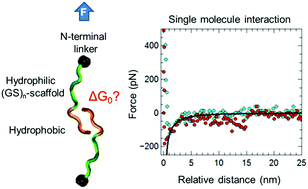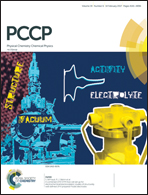Soft matter interactions at the molecular scale: interaction forces and energies between single hydrophobic model peptides†
Abstract
In all realms of soft matter research a fundamental understanding of the structure/property relationships based on molecular interactions is crucial for developing a framework for the targeted design of soft materials. However, a molecular picture is often difficult to ascertain and yet essential for understanding the many different competing interactions at play, including entropies and cooperativities, hydration effects, and the enormous design space of soft matter. Here, we characterized for the first time the interaction between single hydrophobic molecules quantitatively using atomic force microscopy, and demonstrated that single molecular hydrophobic interaction free energies are dominated by the area of the smallest interacting hydrophobe. The interaction free energy amounts to 3–4 kT per hydrophobic unit. Also, we find that the transition state of the hydrophobic interactions is located at 3 Å with respect to the ground state, based on Bell–Evans theory. Our results provide a new path for understanding the nature of hydrophobic interactions at the single molecular scale. Our approach enables us to systematically vary hydrophobic and any other interaction type by utilizing peptide chemistry providing a strategic advancement to unravel molecular surface and soft matter interactions at the single molecular scale.

- This article is part of the themed collection: Soft Matter at Aqueous Interfaces


 Please wait while we load your content...
Please wait while we load your content...